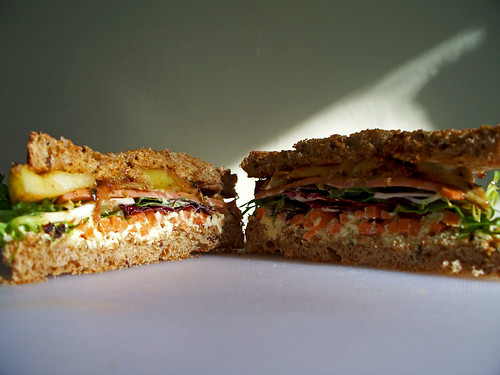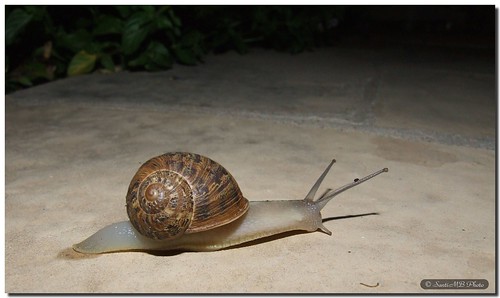A few nice european food recipes images I found:
Food project 1 - This morning's sandwich
Image by dimitridf
First instalment in the Food project series
So here is what I prepared for this morning's sandwich:
Caramelized green apples in mango syrup with melted Swiss cheese; Tofu spread; Tossed European salad and matchsticks carrots; Soy deli slice; Spicy non-dairy mayo; Nine grain toasted bread.
My Food Project Series
Please comment
Slobbing in the night / Babeando en la noche
Image by . SantiMB .
View Large On White
Playing with macro and flash, this snail came into my life...
Jugando con el macro y el flash, este caracol se cruzó en mi vida...
ENGLISH
The word snail is a common name that can be used for almost all members of the molluscan class Gastropoda which have coiled shells in the adult stage. (Those snails which do not have a shell or only a very small shell are usually called slugs.)
The class Gastropoda (the snails and slugs) is second only to the insects in terms of total number of species. Snails are extraordinarily diverse, in habitat, in form, in behavior, and in anatomy, and therefore what is true of one snail species may not at all be true of another, more distantly related one.
Snails can be found in a wide range of different environments from ditches to deserts to the abyssal depths of the sea. The great majority of snail species are marine. Many others are terrestrial, and numerous kinds can be found in fresh water, and even brackish water. Many snails are herbivorous, though a few land species and many marine species are omnivores or predatory carnivores.
Species of land snails live in almost every kind of habitat, from deserts and mountains, to marshes, woodland, and gardens. However, certain species are "anthropophilic", which means they are found most often around human habitation.
Whichever reasonably large land snail species is most commonly seen or most commonly eaten in a given area, that species will usually be referred to simply as "snails" by the local people. In many parts of the world, the fairly large edible species Helix aspersa or Cornu aspersum, has been introduced, and has become a pest in farms and gardens, so this is perhaps a good example of a species commonly known as "the snail."
Snails have been eaten for thousands of years, beginning in the Pleistocene. They are especially abundant in Capsian sites in North Africa but are also found throughout the Mediterranean region in archaeological sites dating between 12,000 and 6,000 years ago. However, it should be noted that wild-caught snails that are undercooked can harbor a parasite that may cause a rare kind of meningitis. Specialized snail caviar is also growing in popularity in European cuisine.
Snails are a delicacy in French cuisine, where they are called escargot. In an English-language menu escargot is generally reserved for snails prepared with traditional French recipes (served in the shell with a garlic and parsley butter).
Snails are also popular in the Portuguese cuisine (although not in the north of the country) where they are called in Portuguese caracóis, and served in cheap snack houses and taverns, usually stewed (with different mixtures of white wine, garlic, piri piri, oregano, coriander or parsley, and sometimes chouriço). Bigger varieties, called caracoletas, are generally grilled and served with a butter sauce, but other dishes also exist such as feijoada de caracóis. Overall, Portugal consumes about 4,000 tonnes of snails each year.
Traditional Spanish cuisine also uses snails ("caracoles"), consuming several species such as Helix aspersa, Helix punctata, Helix pisana or Helix alonensis among others. Small to medium size varieties are usually cooked in several spicy sauces or even in soups, while the bigger ones may be reserved for other dishes such as the "arroz con conejo y caracoles" (a paella-style rice with snails and rabbit meat, very popular in the inner regions of south-eastern Spain).
In Greece, snails are popular in the island of Crete, but are also eaten in other parts of the country and can even be found in supermarkets, sometimes placed alive near partly refrigerated vegetables. In this regard, snails are one of the few live organisms sold at supermarkets as food. They are eaten either boiled with vinegar added, or sometimes cooked alive in a casserole with tomato, potatoes and squashes. A third cooking method is the χοχλιοί μπουμπουριστοί traditional Cretan dish, which consists of fried snails in olive oil with lemon.
In Sicily, snails (or babbaluci as they are commonly called in Sicilian) are a very popular dish as well. They are usually boiled with salt first, then served with tomato sauce or bare with oil, garlic and parsley. Snails are similarly appreciated in other Italian regions, such as Sardinia.
Snails are also very popular in Catalonia, where they are called "caragols" or "cargols." In fact, a snail celebration, the "Aplec del cargol," takes place in Lleida each May, drawing more than two hundred thousand visitors from abroad.
Heliciculture is the farming of snails. "They are protected in the wild almost everywhere (at least, the Roman Snail must not be collected any more), but the Roman Snail and the Garden Snail (Cornu aspersum) especially are cultivated on snail farms."
Snails (or bebbux as they are called in Maltese) are a quite popular dish on the Mediterranean island of Malta.
More info: en.wikipedia.org/wiki/Snail
---------------------------
CASTELLANO
Caracol es el nombre común de los Moluscos Gasterópodos provistos de una concha espiral. Hay caracoles marinos (a veces denominados caracolas), dulceacuícolas y terrestres. Son muy apreciados por el hombre, tanto con fines coleccionistas como gastronómicos.
Pertenecientes al grupo de los pulmonados, su musculosa cavidad paleal, se ha transformado en pulmón. La superficie interior está ricamente vascularizada y debido a que su base está unida al pie, permite la ventilación. Tienen una concha globulosa helicoidal y 2 pares de tentáculos retráctiles, 1 par provisto de ojos y el otro táctil. La concha de la mayoría de los caracoles terrestres se arrolla casi siempre en sentido dextrógiro, es decir en el mismo sentido que las agujas del reloj, aunque en algunas especies su concha lo hace en sentido contrario, levógiro.
El caracol terrestre forma parte de la cocina mediterránea, especialmente la española y francesa, como uno de los manjares más exquisitos. También cabe destacar que al margen de estas cocinas el consumo del caracol se considera un uso culinario extraño, especialmente en la cocina estadounidense y se equipara a consumir una babosa, puesto que el caracol es precisamente eso solo que posee un caparazón propio. Suele cocinarse al hervor y servirse acompañado de diversas salsas, aderezadas con hierbabuena.
Los caracoles son consumidos en diferentes partes del mundo. Aunque escargot sea la palabra francesa para "caracol", escargot en un menú inglés generalmente está reservado para los caracoles preparados con recetas tradicionales francesas (servido con su caparazón y aderezado con ajo, mantequilla y perejil).
Los caracoles son también consumidos en Portugal, donde se les llaman "caracóis", y son servidos en bares y tabernas, por lo general hervidos con ajo. También la cocina tradicional española es muy aficionada a los caracoles, consumiendo varias especies como la Helix aspersa, Helix punctata, Helix pisana o Helix alonensis entre otras. Pequeños o de tamaño medio por lo general, son cocinados en diferentes salsas picantes o incluso en sopas, mientras los más grandes pueden ser reservados para otros platos como el "arroz con conejo y caracoles" (una paella con caracoles y conejo que es muy popular en las regiones interiores del sudeste de España).
Varias especies de caracoles son también consumidas en la cocina asiática.
Más info: es.wikipedia.org/wiki/Caracol
No comments:
Post a Comment